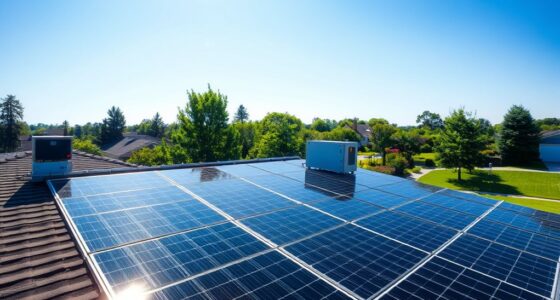Charging your EV at home with solar power is a smart choice that lowers your carbon footprint and reduces energy costs. By installing solar panels, you can generate clean energy and store excess power for nighttime or cloudy days with batteries. Proper system sizing and placement, like south-facing roofs, optimize energy production. Plus, grid integration through net metering can save you even more. Keep exploring to discover how to maximize your solar and EV setup.
Key Takeaways
- Installing a home solar system reduces electricity costs and supports eco-friendly EV charging.
- High-efficiency solar panels maximize energy generation in limited space.
- Integrating battery storage allows for nighttime charging and energy independence.
- Proper system placement and smart inverters ensure seamless energy management and grid interaction.
- Level 2 chargers enable faster, efficient charging directly from solar power or stored energy.

Charging your electric vehicle at home with solar power is an excellent way to reduce your carbon footprint and save money on energy costs. By harnessing the sun’s energy, you can power your EV sustainably and cut down on reliance on the grid. To make this work effectively, understanding solar panel efficiency and grid integration is vital. Solar panel efficiency determines how well your panels convert sunlight into usable electricity. Higher efficiency panels generate more power in a smaller space, which is especially beneficial if your roof has limited area. Choosing panels with ideal efficiency ensures you maximize solar energy production throughout the day, providing a reliable source of power for your EV.
Maximize your EV’s solar power with high-efficiency panels for reliable, sustainable energy in limited spaces.
Grid integration plays an indispensable role in managing your solar power system. When your solar panels produce excess energy, you can feed it back into the grid, often earning credits through net metering programs. This setup allows you to draw on grid power during cloudy days or nighttime, ensuring your EV always has a full charge without relying solely on stored solar energy. Proper grid integration also helps balance your energy flow, preventing overloads and ensuring your system operates smoothly. Many modern inverters and smart meters facilitate seamless communication between your solar setup and the grid, optimizing energy use and storage. Additionally, ensuring your system includes a reliable transfer switch can help protect your equipment and maintain safety during power fluctuations.
You’ll need a home charging station, or Level 2 charger, to efficiently charge your EV from your solar power system. These chargers are faster and more efficient than standard outlets, allowing you to fully charge your vehicle overnight or during the day when your panels are generating surplus energy. When installing your system, consider the placement of your solar panels to maximize solar exposure and overall efficiency. A south-facing roof with minimal shading is ideal, but even east- or west-facing panels can work well with appropriate system sizing.
Battery storage adds another layer of efficiency to your setup. With a home battery system, you can store excess solar energy generated during the day for use at night or on cloudy days. This not only enhances your independence from the grid but also helps you capitalize on high solar production periods, reducing energy costs further. When integrating your solar panels, charger, and storage, verify your system is properly sized and compatible. Consulting with a professional can help you optimize solar panel efficiency and grid integration, ensuring your entire setup functions smoothly and provides reliable, clean power for your EV.
Frequently Asked Questions
How Much Does Installing a Home Solar EV Charger Typically Cost?
Installing a home solar EV charger usually costs between $1,000 and $3,000, depending on your system size and installation process. For accurate cost estimation, consider factors like equipment quality and labor. You’ll need to work with a professional for the installation process, which guarantees safety and efficiency. Keep in mind, some rebates or incentives can lower your overall expenses, making it a worthwhile investment in your electric vehicle setup.
Can Existing Home Electrical Systems Support Solar-Powered EV Charging?
Your existing electrical system might support solar-powered EV charging, but you should start with a power capacity assessment. If your panel is outdated or undersized, electrical panel upgrades may be necessary to handle the additional load. A professional electrician can evaluate your system and recommend upgrades to guarantee safe, efficient charging. This way, you can confidently incorporate solar energy into your EV charging routine without risking overloads or electrical issues.
What Are the Maintenance Requirements for Solar EV Charging Systems?
Think of your solar EV charging system as a garden needing regular care. You’ll want to keep solar panels clean through periodic solar panel cleaning to maximize efficiency. Additionally, monitor your inverter regularly for potential issues and troubleshoot inverter problems promptly to avoid disruptions. These simple maintenance steps make certain your system runs smoothly, saving you money and keeping your EV charged with clean, renewable energy.
How Does Weather Impact Solar Energy Generation for EV Charging?
Weather considerably impacts your solar energy generation for EV charging. Cloud cover reduces sunlight, lowering energy output, especially during overcast days. Seasonal variation also plays a role; winter months often see less solar efficiency due to shorter days and less intense sunlight. To optimize charging, you might need to adjust your system or plan charging times around weather patterns, ensuring you get the most out of your solar setup regardless of weather changes.
Are There Government Incentives for Solar-Powered Home EV Chargers?
Yes, there are government incentives for solar-powered home EV chargers. You can take advantage of government rebates and incentive programs that help reduce your installation costs. These programs are designed to encourage clean energy use and make solar and EV charging more affordable for you. Be sure to check your local and federal programs, as eligibility and benefits can vary, and taking advantage of these incentives can save you money long-term.
Conclusion
Charging your EV at home with solar is a smart, eco-friendly choice, saving you money and reducing your carbon footprint. Some worry about the upfront costs or installation hassle, but the long-term benefits outweigh these concerns. With incentives and decreasing solar prices, going solar for your EV is more accessible than ever. Don’t let perceived obstacles hold you back—take control of your energy and drive greener today!










